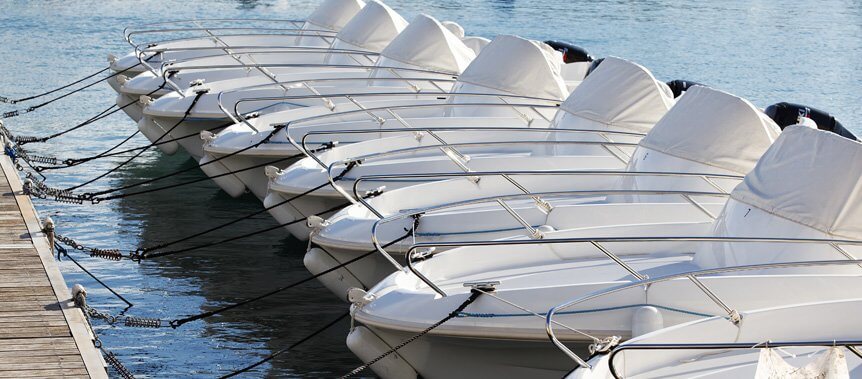Weather reports have finally convinced you it’s time to put away your boat, jet ski, or WaveRunner for the winter. If you want your watercraft to be ready for spring, it is essential to winterize before leaving it in storage. A full 40 percent of the time, insurance claims made on boats involve damage that occurred during winter storage. The following are examples of what can happen without winterization and steps you can take to protect your boat, WaveRunner, or jet ski during the off-season.
Tips to Winterize a Boat for Storage
A few winterization steps can literally save your boat, whether you dock it or store it in your driveway, in your garage, in dry rack storage, or at a self-storage facility in winter. Avoid storing on a trailer, since tires and bearings tend to wear down over long periods of time. Instead, you can mount your boat on supports. All steps needed may differ, according to the storage location. The following are basic winterization tips for boats (they generally apply to jet skis and WaveRunners, as well):
- Do an inspection of the condition of your boat and engine during your last run before putting your boat in storage. If there are any cracks, such as in the hull, the damage should be repaired before lengthy winter storage. Otherwise, the damage could worsen significantly.
- After removing your boat from the water, drain it thoroughly. To accelerate the process, it helps to raise the bow. Drain the head, pipes, seacocks, water tanks, and bilge. Hold off on draining the engine water until you have winterized the engine.
- Give your boat a thorough scrubbing, including drawers, freezers, refrigerators, and any barnacles and other plant life attached to the hull. After the boat has dried completely, wax and evenly polish the superstructure and hull.
- Winterize the engine, which involves flushing it, including the coolant system, with freshwater for the purpose of removing dirt, corrosion, and salt. Then add antifreeze to the coolant system. Warm the engine briefly to loosen impurities and then replace filters and the oil. Take note if there is a milky aspect to the old oil because it signifies that there has been water intrusion. Put an application of fogging oil into the spark plug holes and carburetor. To prevent belts from snapping due to tension, remove and store drive belts during winter. Fill the engine with a full tank of gas and add a stabilizer. Then, for approximately 15 minutes, run the engine to make sure additives reach fuel lines.
- Remove the battery and give it a full charge. Clean and slightly grease battery terminals and battery cable ends. Store the battery in a dry, warm place until the boat is put back in use.
- Apply moisture-displacing lubricant on moving metal parts such as latches, linkages, and hinges. Grease control mechanisms and the steering system. Detach, inspect, and lubricate the propeller and then put it back in its position.
- If your boat has exhaust ports, seal them off with duct tape. This helps to prevent components from getting clogged by pests.
- Remove and store away all items that are not part of the vessel. This includes life jackets, flares, fire extinguishers, fabric and leather components, and electronics.
- Cover your boat, even if it is stored under a roof. If you live in a harsh winter environment, consider shrink-wrapping your boat, as an extra measure of protection.
Boat Damage that Can Occur in Winter Storage
Properly winterizing and storing a boat is well worth the time and care put into it. If the recommended steps are neglected, various forms of disaster could very well greet you come spring.
Sinking from Snow
About 10 percent of all sinkings that occur in the boat slip are caused by water getting into the boat through a fitting above the waterline. What pushes a boat down past the waterline? In winter, the weight of snow sinks a boat further and further into the water. Avoiding this problem has a two-fold solution. First, take the step of ensuring that the boat has power from well-charged batteries or shore power to keep pumps running, in the event water gets in. A winterization step for some inboard-powered boats is to plug the exhaust ports. Secondly, check your boat after every snowfall. Remove snow, as needed.
Failure to Protect from the Elements
If at all possible, avoid storing your boat or jet ski where it is exposed to harsh weather. If you can’t avoid it, be aware that simple tarps secured over a watercraft are widely known to spoil a shiny finish. Padding with a sheet or blanket is sufficient to protect the finish from the abrasiveness of tarps, which rub, shift, and move with the wind.
Winterizing Jet Skis and WaveRunners
The steps for winterizing WaveRunners and jet skis are essentially identical to those for a boat. There can be important differences, however, depending on manufacturer’s instructions. Refer to those instructions and make any needed adjustments to properly prepare your jet ski or WaveRunner for off-season storage.
All the enjoyment you get from your boat, jet ski or WaveRunner could be delayed or cut short by lack of proper winterization. When you’re ready to hit the water come spring, you will be so glad you learned how to properly put your watercraft up for storage.

